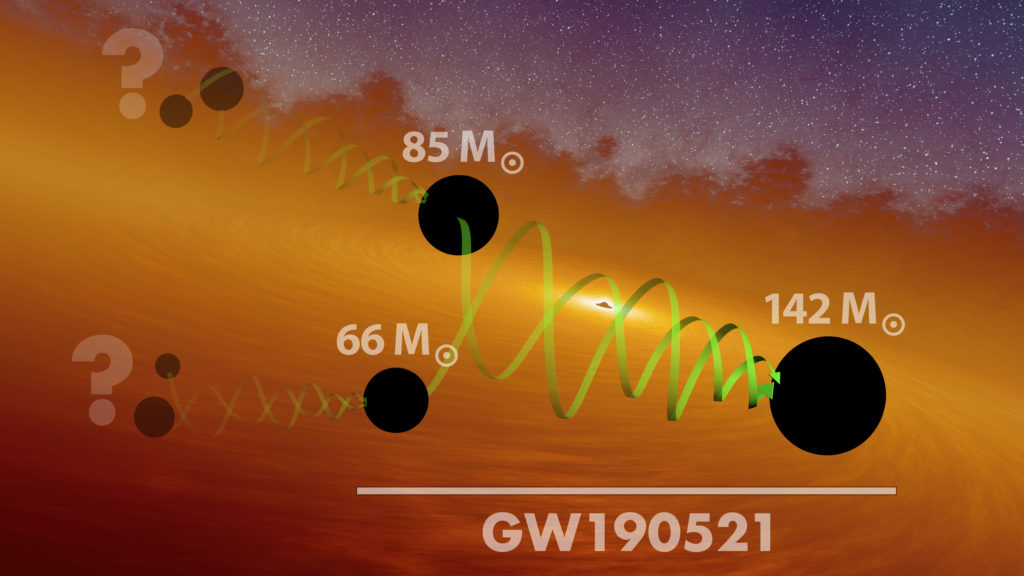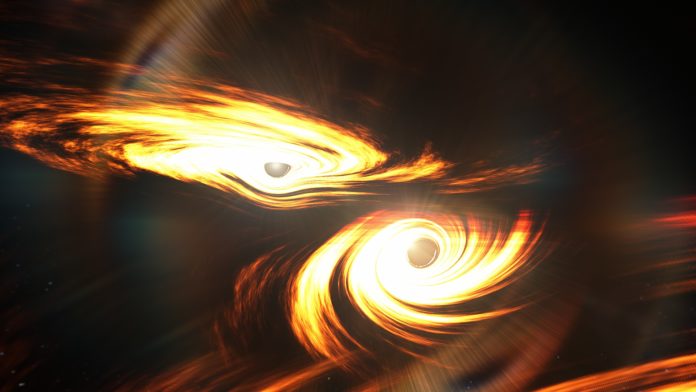Astronomers have long theorized about the existence of intermediate-mass black holes: gravitational singularities midway in size between the small, stellar-mass black holes that form when giant stars die and the supermassive black holes that lurk at the hearts of galaxies.
Now, thanks to new observations from the Virgo and LIGO Scientific Collaborations, astronomers finally have direct evidence that intermediate-mass black holes do indeed exist. The results included contributions from the Université de Montréal, and were published in Physical Review Letters.
Not too big, not too small
A black hole is a region in space with an incredibly strong gravitational field — so strong, in fact, that not even light can escape if it gets too close. At the centres of black holes, enormous amounts of mass are compressed into infinitely small spaces, and the laws of physics begin to break down. This infinitely-dense point is known as the black hole’s gravitational singularity.
Astronomers typically group black holes into three main categories: stellar-mass black holes, intermediate-mass black holes, and supermassive black holes.
Stellar-mass black holes are those less than about a hundred times the mass of the Sun, and they’re formed when high-mass stars end their lives in massive supernova explosions. The innermost regions of these stars collapse in on themselves, forming a black hole in the process.
Supermassive black holes, on the other hand, are millions (or billions) of times more massive than stellar-mass black holes. They’re believed to exist at the centres of most galaxies, including our own Milky Way, but astronomers still aren’t entirely sure how these enormous black holes form. The very first image of a supermassive black hole was taken in April of last year.
In between these two ends of the spectrum are intermediate-mass black holes, which range in mass from 100 to 1,000,000 times the mass of the Sun. Astronomers have been searching for intermediate-mass black holes for years, and many believe that these mid-sized black holes could be precursors to the much-larger supermassive black holes, helping to explain how supermassive black holes form in the first place.
Tentative detections of intermediate-mass black holes have been made in the past, but various uncertainties made it difficult to determine whether the detections really were the “missing link” in the black hole size spectrum after all.
Gravitational waves lend a hand in the search
In recent years, however, gravitational wave astronomy has opened a new window on our Universe. While typical astronomical observations are made using light, gravitational wave astronomy involves measuring the ripples in spacetime caused by collisions between massive objects.
This is an especially important tool for astronomers interested in learning about black holes, because black holes don’t emit light of their own. Over the past several years, the Laser Interferometer Gravitational-Wave Observatory (LIGO) and Virgo Interferometer have detected gravitational waves from a number of massive collisions from the distant Universe by measuring the slight stretching and compressing of space when these gravitational waves pass by the observatories.
The animation below, from the LIGO Lab Caltech: MIT, illustrates how exactly these detections are made.
Many gravitational wave sources have been detected over the years. In early September 2020, however, the two collaborations announced a collision unlike any they’d observed before: two stellar-mass black holes that had merged to form a single intermediate-mass black hole approximately 142 times the mass of the Sun. This observation marks the first definitive proof of intermediate-mass black holes in the Universe, and also demonstrates that intermediate-mass black holes can be formed from collisions of their smaller, stellar-mass cousins.

The amplitude of a gravitational wave signal depends on the size of the objects involved in the collisions, which is how the scientists responsible for the discovery were able to determine the size of the resulting black hole.
This observation also marked both the most massive gravitational wave source detected to date, as well as one of the most distant. The astronomers involved estimated that the collision occurred five gigaparsecs, or 16 billion light-years, away from the Earth, at a time when the Universe was only half of its current age.
More questions than answers
While this observation does answer the question of whether or not intermediate-mass black holes exist, it has also led to a number of new questions for black hole astronomers.
In particular, the two stellar-mass black holes involved in the collision had masses that astronomers didn’t previously think were possible. While astronomers can explain black holes up to about 65 times the mass of the Sun and around 100 times the mass of the Sun with supernova explosions, a phenomenon known as pair instability is thought to prevent black hole remnants from forming in the mass range between 65 to 100 times the mass of the Sun.
The black holes involved in this collision, however, had masses of 66 and 85 times the mass of the Sun — right in the so-called “pair instability mass gap” where supernova explosions shouldn’t be able to form black holes.
“The fact that we’re seeing a black hole in this mass gap will make a lot of astrophysicists scratch their heads,” said Nelson Christensen, a researcher at the French National Centre for Scientific Research (CNRS) who was involved in the study.
“This event opens more questions than it provides answers,” added Alan Weinstein, a professor of physics at the California Institute of Technology.
“From the perspective of discovery and physics, it’s a very exciting thing.”








































